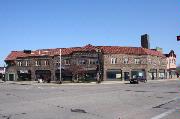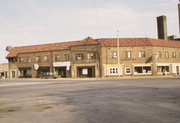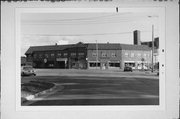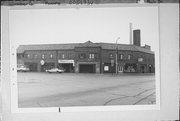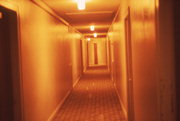Property Record
1 MAIN ST
Architecture and History Inventory
| Historic Name: | Brin Building |
|---|---|
| Other Name: | Teresa's House of Treasures and Toy Man Collectibles |
| Contributing: | |
| Reference Number: | 59734 |
| Location (Address): | 1 MAIN ST |
|---|---|
| County: | Winnebago |
| City: | Menasha |
| Township/Village: | |
| Unincorporated Community: | |
| Town: | |
| Range: | |
| Direction: | |
| Section: | |
| Quarter Section: | |
| Quarter/Quarter Section: |
| Year Built: | 1928 |
|---|---|
| Additions: | |
| Survey Date: | 2009 |
| Historic Use: | small office building |
| Architectural Style: | Spanish/Mediterranean Styles |
| Structural System: | |
| Wall Material: | Brick |
| Architect: | H. D. Werwath (Milwaukee) |
| Other Buildings On Site: | |
| Demolished?: | Yes |
| Demolished Date: | 2018 |
| National/State Register Listing Name: | Brin Building |
|---|---|
| National Register Listing Date: | 7/10/1986 |
| State Register Listing Date: | 1/1/1989 |
| National Register Multiple Property Name: |
| Additional Information: | A 'site file' exists for this property. It contains additional information such as correspondence, newspaper clippings, or historical information. It is a public record and may be viewed in person at the State Historical Society, Division of Historic Preservation. The Brin Building is historically significant for its contribution to the early 20th century development of Menasha's commercial corridor. Seven structures were part of this development: the Hotel Menasha built in 1905 (177 Main Street, NRHP 1984); the First National Bank built in 1917 (175 Main Street), the Tayco Street Bridge built in 1928, the Brin Building also built in 1928, the Northwest Electrotype and Engraving Company Offices and Plant built in 1930 (214 Washington Street), the Menasha U.S. Post Office built in 1933 (84 Racine Street), and Verbrick's Gas Station built in 1935 (216 Washington Street). The construction of these buildings established the city's present day commercial corridor: Washington, Tayco, Main and Racine. Of these seven buildings the Brin proved a significant expansion to local retail space. All other commercial buildings in the city were at the time single and double store constructiuon. The Brin Building was designed in 1928 by Milwaukee architect H.D. Werwath and was constructed at a cost of $140,000. The largest commercial building in the city, the Brin included a bowling alley, several stores, seven apartments, and a 932 seat theater. It was owned by Leonard K. Brin, who owned and operated the Fischer Theater Chain. At first referred to as the Werwath reigned as Menasha's permiere movie house until 1969. The basement housed C. A. Hendy's Recreation Parlor which featured twelve bowling lanes and a soda fountain. Among the seven stores in the building were the Schlintz Brothers Company (a drug store), the Menasha Wholesale Store (dry goods and men's ready to wear), Kuester's Brown Built Shoe Store, and the watchmaking shop of William J. Sieger. Among the apartment occupants on the second floor were C.A. Hendy, and Al Cube, who ran Al Cube's School of Hawaiian Music from his apartment. The Brin Building is historically significant for its contribution to the early 20th century development of Menasha's commercial corridor. The Brin Building is located in the industrial city of Menasha, on the main corridor of travel between Menasha and Neenah and near the southern end of the central business district. Situated on the corner of Main and Tayco Streets, the Brin Building is a two story brick commercial building from the Mediterranian Revival period of construction. The configuration is T plan, and the roof combines hipped, flat, and arched forms. The visible roofing materials are red tiles, the walls are brown brick, and the foundations are concrete. The first floor of the front facade consists of seven altered storefronts defined by flat brick arches with stone springers. On the second floor the balanced fenestration consists of paired windows with double-hung, multi-pane sash. A hipped pavilion is the focal point of the facade and serves as the entrance to the 932 seat Brin Theater. On the first floor the entrance to the theater has been removed, while on the second floor the two original groups of double-hung, multi-pane sash windows are intact. Decorative features include a corbelled brick cornice and brick quoins on the hipped pavilion, and a bracketed second floor canopy over the Main Street entrance. First floor canopies have all been removed. The interior of the building includes an unoccupied basement which once held twelve bowling lanes, soda fountain, and various smaller rooms. The theater portion, also unoccupied, includes a large stage with its asbestos curtain marked BRIN. All the seats in the theater have been removed, although some wall decorations still remain. The stores have all undergone alterations typical of their age, while the modest apartments on the second floor are largely unaltered. Although altered, the Brin Building retains integrity of site and form and is historically significant as Menasha's premiere commercial block. 2009--Last surveyed in 1989--While the block itself remains intact, new fenestration is found throughout the building. The building was significantly damaged in a fire in August 2018. |
|---|---|
| Bibliographic References: | A. Upper Main Street Historic District nomination papers. Menasha Record: August 31, 1929. Menasha 1931 Tax Records. Menasha Record; Kuly 8, 1933. B. Ibid.; September 21, 1928. C. Ibid.; July 25, 1928. D. Johnson's Neenah Menasha Directory; 1970, page unnumbered. E. Ibid.; October 30, 1928. F. 1931 Neenah Menasha Directory; page 15. Neenah Citizen 12/10/1999. |
| Wisconsin Architecture and History Inventory, State Historic Preservation Office, Wisconsin Historical Society, Madison, Wisconsin |

